What is a student information system (SIS) ?
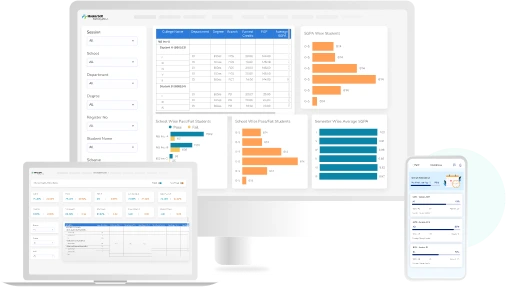
A Student Information System (SIS) is a modern ERP software that acts as a multi-purpose tool for institutes to cater to their essential needs. It helps institutes coordinate, schedule, and communicate between faculty and administrative departments.
It provides a common medium through which parents and institute management can track and retrieve crucial student information. Moreover, SIS or SMS (Student Management System) tracks and manages students’ grades, attendance, and other institutional records.
It eliminates the regular manual intervention and automates the collection of students’ admission and registration information. Likewise, it updates data for fee payments, hostel billing, scholarships, other financial aid provisions, etc.
How does a Student Information System (SIS) work?
Schools and colleges need a well-designed system to organize their information, which helps them save time and effort. That is exactly what MasterSoft’s student information system (SIS) provides in terms of a comprehensive solution to institutional data processes.
It automates the storage and maintenance of different kinds of data, eliminating the need for paper-based data. Teachers, staff, and students can access the system with a highly secure login and check grades, assignments, upcoming events, etc.
Also, the system generates reports on student performance and enables the management to monitor faculty performance simultaneously. In effect, it helps to make data-driven decisions in all aspects of institutional function.

Why choose MasterSoft’s Student Information System (SIS) ?
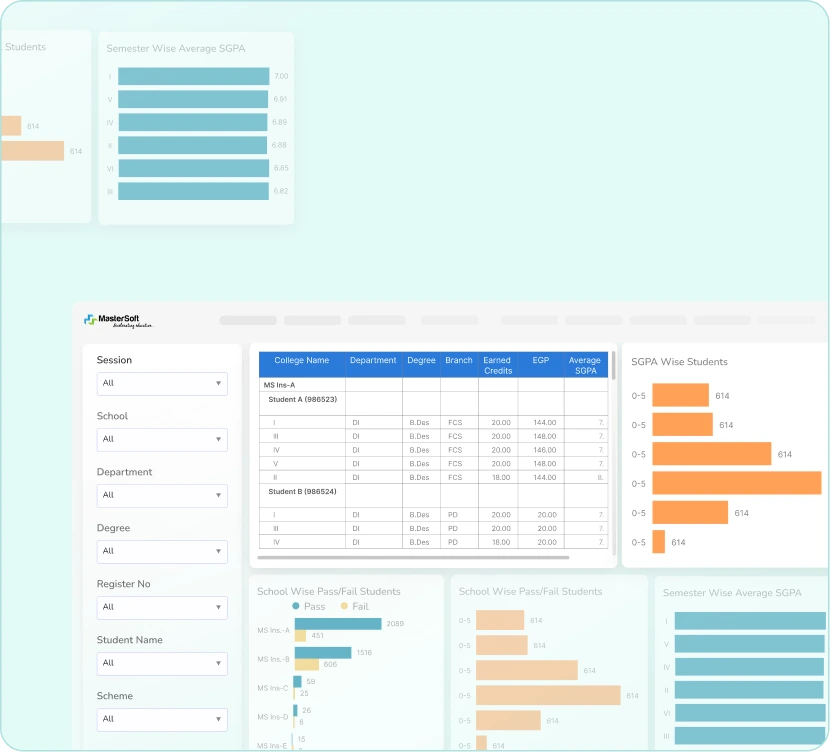
Elevating or maintaining an institution's efficiency relies on effective student data management and robust academic progress-tracking mechanisms. That is exactly why the student information system (SIS) is an ideal tool, as it manages student data and provides various benefits, such as:
![]() Effortless student data management
Effortless student data management
![]() A centralized platform that enables convenient storage and sharing of student information
A centralized platform that enables convenient storage and sharing of student information
![]() AI-powered dashboards track and evaluate student progress in real-time.
AI-powered dashboards track and evaluate student progress in real-time.
![]() It breaks down the communication gap between teachers, parents, and students.
It breaks down the communication gap between teachers, parents, and students.
![]() Provides a secure, user-friendly interface for stakeholders to access results, academic reports, schedules, and other educational data.
Provides a secure, user-friendly interface for stakeholders to access results, academic reports, schedules, and other educational data.
Features Of Student Information Management System (SIMS)

Reduced Paperwork
The student admissions process entails a lot of paperwork, from students filling out the admission forms to submitting their documents. SIS eliminates paperwork effectively through successful digitalization.
It automates the end-to-end admission process; hence, students can complete enrollment forms and submit them with the necessary documents digitally. At the same time, they can pay the admission fees and retrieve the invoice.
The admin doesn’t need to store physical copies of the invoice as the system saves it automatically on the cloud server. In effect, they can obtain it per the requirement during the audit process.

Student Record Maintenance
Teachers and administrators are responsible for developing and handling student information, and any error can lead to inconsistency and confusion. The software is an ideal tool that uploads and organizes data through student data management.
In fact, it facilitates a smooth streamlining of student information, enabling teachers to access specific data accordingly. Therefore, they do not need to go through paper-based files or folders trying to find a particular document.
Furthermore, the system ensures the safekeeping of student records through various security mechanisms. As a result, authorized personnel can access the data with valid credentials while raising alerts during attempts at unauthorized access.

Online Fee Payment
Timely payment, collection of monthly fees, and maintenance of the receipts are pivotal parts of the institute’s financial management. MasterSoft’s SIS integrates with payment gateways, enabling students to pay fees online.
The system sends a notification after the completion of the transaction along with a digital copy of the invoice. Additionally, the system sends auto-messages or notification alerts to students and parents, reminding them of the due date.
In effect, it helps them to pay fees on time, which in turn helps to avoid missing the last date or paying a fine.

Analytics Tools And Dashboard
The analytic tool and dashboard are key parts of the software, as they enable faculty and administrators to go beyond student data management. These two features allow them to get a better understanding of student's performance and problem areas.
The tools collect and analyze student data, including grades, attendance records, exam scores, and demographic information. It executes data analysis by identifying patterns, trends, and correlations with the data.
Consequently, it helps to point out vital outcomes, such as at-risk students, courses or programs with higher dropout rates, etc. Likewise, the dashboard provides insights into important components such as students’ performance and school-wide trends.
Hence, the analytic tools and dashboard are significant as they help to evaluate institutional and program efficiency.

Cloud-based Technology
Many people point out the disadvantage of losing data if they fail to save their work on their system. However, with SIS, institute team members can be stress-free as the software automatically saves data through cloud technology.
What’s more, institutes don’t need to invest in expensive hardware and software licenses; instead, they need to pay a subscription fee, depending on features and requirements. Besides, it enables authorized users to access data from anywhere and anytime.
Additionally, cloud technology manages software updates and maintenance, ensuring that institutes can access the latest features and security upgrades.

Online Registration
One of the initial steps of the admissions process is the registration procedure, which students must fulfill accordingly. That is where SIS can prove to be an immensely useful tool, as it allows students to register themselves online.
Furthermore, the online submission of documents simplifies the admission process for both the administrative staff and students. Also, it saves time and effort and improves accessibility for all students.

Smooth Communication
Establishing and maintaining communication between all stakeholders is the key to attaining institutional productivity and avoiding misunderstandings. Hence, SIS has been developed to facilitate effective communication through the following features:
- Announcements: Institutes can share important announcements regarding upcoming events and policy updates. Likewise, they can make changes to the schedule and notify students and faculty through message boards and announcements.
- Targeted Messages: Faculty can send individualized or common messages to all students, which can help them share assignments or provide feedback.
- Parent-Teacher Communication: It provides a common platform for teachers to connect with parents and vice versa. Consequently, it helps parents stay up-to-date with their children’s progress.
- Discussion Forums: Students can use the discussion forums to interact with each other or discuss topics. It helps to promote collaboration and peer learning and create an engaging learning environment.

Mobile Interoperability
Most advanced systems enable users to access the features through their smartphones, ensuring smooth accessibility. As a result, students can access their class schedules, assignments, grades, and attendance records in real-time.
Simultaneously, they can access learning materials, course notes, and online resources from anywhere, anytime. In effect, it contributes to continuous learning, helping them to complete their assignments or study.
On the other hand, parents can monitor their children’s activities and academic performance and communicate with teachers through messages.
Managing Student Data with a Robust Student Information System (SIS)
Inconsistent or disorganized maintenance of student information can lead to confusion and further issues. That is why, managing student data is significant and Student Information System (SIS) is an ideal software solution that organizes and maintains student information effectively.
Moreover, institutes can automate repetitive administrative activities such as grading, attendance tracking and maintaining communication with stakeholders.

Key Statistics
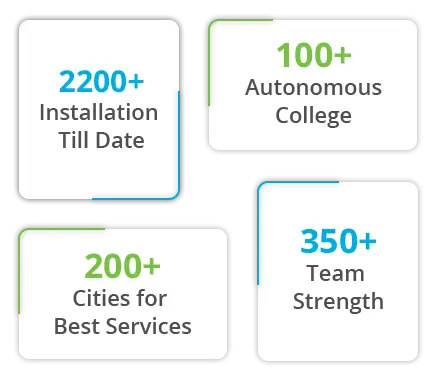
Why is MasterSoft India's Most Trusted Partner?

Academically Driven

Excellent Service Support Engine

Diverse Experience with Tested Products from Industry Experts

We Take Institutes Forward for a Better Future
Student Information System (SIS)
Admission Form Fillings and Portal: Simplify the application process with MasterSoft's user-friendly portal. Students can complete forms, upload required documents, and submit applications online easily, reducing paperwork and saving time for administrative staff.
Document and Certificate Management: Securely store, manage, and retrieve student documents and certificates in a centralized system, ensuring quick access and data security.
Entrance Test Scheduling and Offer Letter: Schedule entrance tests efficiently and generate personalized offer letters automatically, eliminating manual tasks and enhancing communication with applicants.
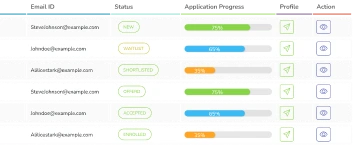
Fee Collection and Scheduling: Ensure smooth and hassle-free fee payments with automated schedules, timely reminders, and multiple payment options for better convenience.
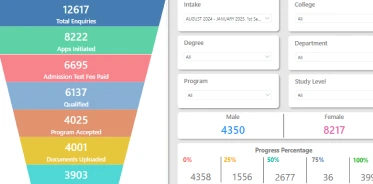
Enrollment : Streamline the enrollment process with guided workflows that reduce errors and administrative burdens, making it simpler for students and staff.
Academic Management: Sectioning and Scheduling Manage courses, section students seamlessly, and create schedules efficiently using MasterSoft's advanced academic management tools.
Attendance: , Timetable, and Room Allocation Track attendance effortlessly, generate accurate timetables, and allocate classrooms efficiently with integrated smart solutions.

Continuous Assessment: Monitor student performance consistently through continuous assessment features, providing valuable insights for better academic outcomes.

Grade Entry and Results: Simplify grading with user-friendly entry tools and publish accurate results instantly, ensuring a smooth and transparent evaluation process.
Learning Gap and Outcomes : Identify learning gaps, analyze student outcomes, and implement strategies to improve academic success with actionable insights.
Feedback and Suggestions: Online Promote meaningful interactions between students and faculty through MasterSoft’s online feedback system, fostering a culture of improvement.

Dashboard, Reports, and AI-Enabled Query Management: Gain valuable insights through real-time dashboards and generate comprehensive reports. Resolve queries faster with AI-powered tools designed to enhance decision-making.

Benefits of Student Information Management System
The following list points out the benefits of a student management system for teachers, institutional administrators, students and parents.
For Teachers
Managing student information becomes relatively simple and convenient for teachers as the SIS reduces paperwork and spreadsheets. It takes merely a click of the mouse to check students’ academic history, attendance records and demographic information.
Student Information System (SIS) provides a centralization of all student-related information in one place. In effect, it simplifies data accessing and sharing, whereas data encryption prevents unauthorized access.
The software generates accurate reports on grades, attendance, participation, etc. Therefore, it allows teachers to evaluate student’s achievements and problem areas simultaneously. Also, it helps them make decisions regarding instructional practices.
It facilitates a smooth communication system between parents, students and teachers by providing timely updates on student progress, assignments and upcoming events.
For Administrator
SIS uses modern security mechanisms to protect student and institutional data and financial details.
All institute members such as teachers, registrar, or finance officer, can access the system with valid credentials. Also. SIS’s role-based access prevents unauthorized access and accommodates new users accordingly.
Digitalization of admission-related tasks such as form submission, document verification, and fee payment simplifies the overall enrollment procedure. Likewise, it enhances student’s experiences by facilitating communication between admission officers, applicants, and parents.
SIS automates core administrative activities such as attendance tracking, report generation, and scheduling. In effect, it reduces human errors and enhances data accuracy.
For Students
Students can access academic information, including grades, schedules, and other relevant educational data.
They can reach out to teachers through personalized communication channels and solve their queries. Furthermore, they can make appropriate adjustments based on the teacher’s feedback. In effect, it contributes to creating a productive and collaborative teacher-student relationship.
Students remain up-to-date with upcoming exams, deadlines, and important school events, thanks to real-time notifications.
One of the best features of the SIS is the dashboard that enables students to self-evaluate their academic performance. At the same time, they can assess their areas of strength and shortcomings efficiently.
Students can check their exam timetables and track their daily attendance and other important academic information. As a result, it motivates them to manage their schedule effectively and organize activities accordingly.
For Parents
SIS improves the admission process by making it less labour-intensive and more efficient. Parents can complete the entire admission process through online mode and track their children’s application status. Additionally, they can complete the fee payment and retrieve e-receipts.
Parents can gain real-time insights into their children’s academic performance by tracking their assignment submissions and class engagement.
Student Information System (SIS) dashboards allow parents to check grades, attendance, and overall progress. Therefore, they can evaluate whether they have made any progress.
The software has built-in features which enable parents to get notifications about their children’s attendance, disciplinary actions and behavior.
Benefits Of Student Management System (SIMS)?
The following list depicts the benefits of the Student Information Management System for teachers, institutional administrators, students, and parents.
Institutional Data Privacy
& Security
Student Information System (SIS) play a pivotal role in safeguarding institutional data. Administrators benefit from enhanced data protection, ensuring that sensitive information—ranging from student records to financial details—is securely stored. By centralising data management, Student Information System (SIS) adheres to privacy regulations, implementing robust security measures and access controls. Additionally, audit trails allow administrators to track any modifications, maintaining transparency and accountability.
Centralised Platform with
Role-Based Access
Student Information System (SIS) provides administrators with a unified platform for managing user accounts. Role-based access ensures that each staff member has appropriate permissions based on their responsibilities. Whether it's a teacher, registrar, or finance officer, granular permissions allow precise control over data access. As institutions grow, the Student Information System (SIS) seamlessly accommodates new users, adapting to changing organisational structures.
Streamlined Online
Admission Process
Admission procedures become more efficient with SIS. Automation simplifies tasks such as form submission, document verification, and fee payment. Applicants can apply online, reducing paperwork and manual data entry. Moreover, the Student Information System (SIS) facilitates communication between admission officers, applicants, and parents. Notifications about deadlines, interview schedules, and acceptance letters are sent automatically, ensuring a smooth process.
Automated Administrative
& Non-Administrative Tasks
Student Information System (SIS) significantly boosts efficiency by automating routine administrative tasks. Attendance tracking, report generation, and scheduling become seamless. This automation minimises human errors in data entry, ensuring accurate records. For instance, automated grade calculations enhance grading accuracy. Furthermore, the Student Information System (SIS) handles financial management, including billing, fee collection, and financial reporting, streamlining administrative processes.
User-Friendly Navigation
with Multi-Language Support
A well-designed Student Information System (SIS) interface prioritises user experience. Responsive design ensures intuitive navigation menus and clear labels. Administrators can quickly locate the information they need. Additionally, the Student Information System (SIS) supports multiple languages, allowing administrators from diverse backgrounds to work comfortably. Whether accessing critical features from a desktop or mobile device, the system promotes efficient collaboration.
Transform your institute's operations and unlock a world of possibilities with MasterSoft's innovative Student Information System.
Get StartedTypes of Schools That Can Benefit from Using a
Student Information System (SIS)
 K12 Schools
K12 Schools
The K12 schools comprise of elementary, middle and high school students. The SIS helps them immensely in enrolling students and interacting with their parents seamlessly on their progress.
 Private Schools
Private Schools
The SIS helps the private schools in curating a customized curriculum for the students. It further helps them in their grade management. Additionally, it aids the finance department by easing their tasks.
 International Schools
International Schools
International schools face challenges in dealing with multi-cultural students. The SIS helps them in managing data transfer between countries and supports multilingual interfaces.
 Higher Education Institutions
Higher Education Institutions
Higher education institutions like colleges and universities handle a vast amount of data of students enrolled in different programs. SIS helps the management keep a track of it with ease.
 Vocational Schools
Vocational Schools
These institutions focus on skill-based learning. Hence, they have different needs from the SIS. An ideal SIS helps them to track the apprenticeship and certification details for different students.
 Specialized Schools
Specialized Schools
Specialized schools who teach gifted children benefit from the custom-made SIS. It helps them to prepare advanced curriculum for special students and collaborate with parents on their progress seamlessly.
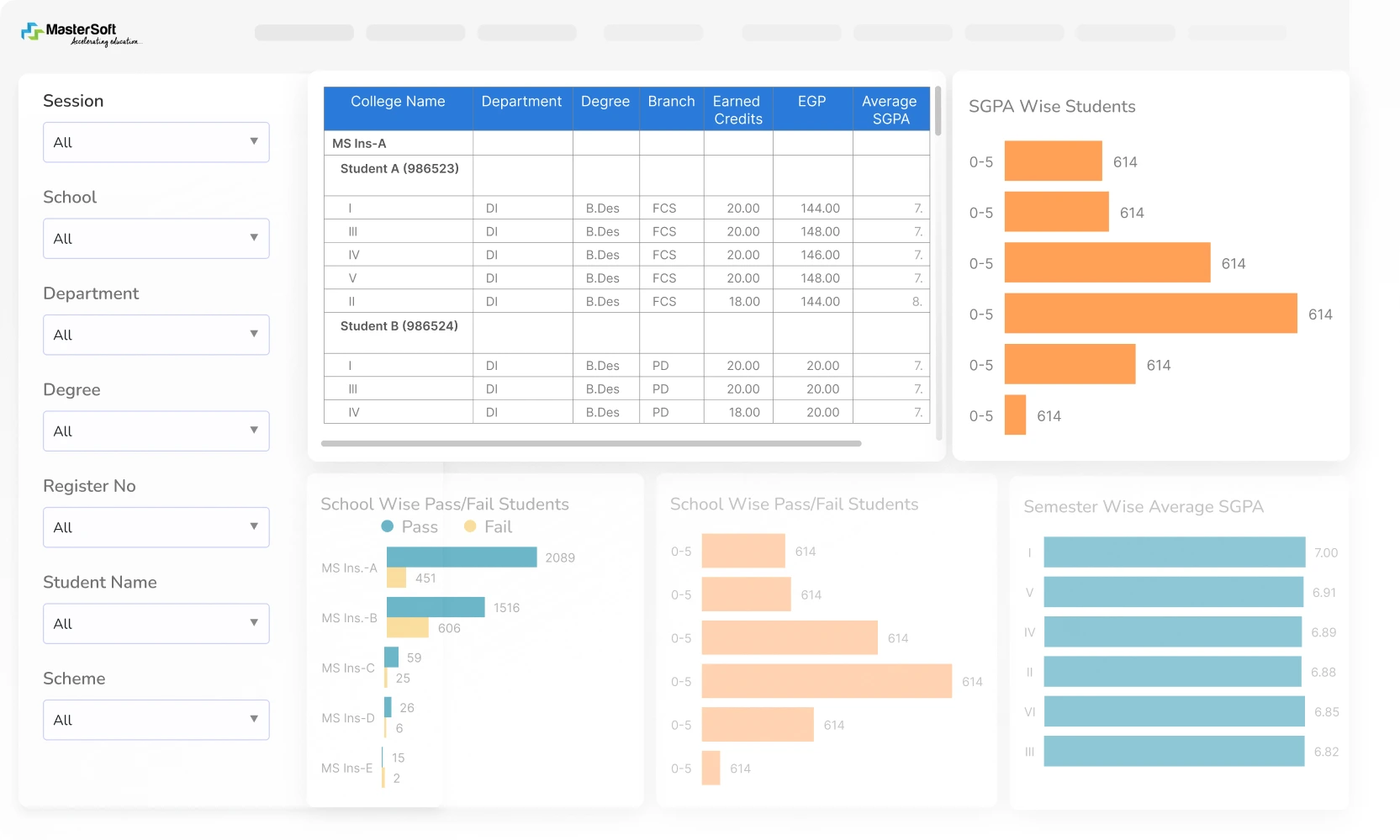
Student Information System (SIS) Assists The Institutions
The functionalities offered by the SIS ease the tasks for the entire academic lifecycle of a student. Let us see the functionalities that help the schools in particular.
 Manage every single detail about students in a holistic, organized, and cost-effective way.
Manage every single detail about students in a holistic, organized, and cost-effective way. Education ERP efficiently eliminates the need for faculty members to spend a considerable amount of time compiling student data.
Education ERP efficiently eliminates the need for faculty members to spend a considerable amount of time compiling student data. Assists the faculty members in channelizing their concentration on the students and their performance enhancement.
Assists the faculty members in channelizing their concentration on the students and their performance enhancement.
Student Information System (SIS) Features That Facilitate
Key Institution Tasks and Processes
The functionalities offered by the SIS eases the tasks for the entire academic lifecycle of a student.
Let us see the functionalities that help the schools in particular.
 Admission Management
Admission Management
The schools’ entire enrollment process is automated with the help of SIS. It takes care of the online registration and document verification. This significantly reduces the paperwork making the process more sustainable.
 Attendance Management
Attendance Management
SIS helps the teachers manage attendance digitally. It helps in generating detailed attendance reports. Moreover, it generates alerts in case of excessive absenteeism.
 Grade Management
Grade Management
The feature of gradebook integration in SIS helps in generating results in a seamless and swift manner. The comprehensive reports generated by the tool help the teachers analyze the students' reports who need extra attention.
 Schedule Management
Schedule Management
This feature helps the teachers to automatically create a conflict-free timetable. This scheduling also helps in hybrid mode where the classes can be taken both offline and online. Moreover, it provides alerts and notifications in case of any changes.
 Financial Management
Financial Management
The SIS benefits the finance department as well. It helps in generating alerts in case of any dues. It further aids in financial management by generating payment receipts and invoices.
 Student Records Management
Student Records Management
SIS is a centralized repository of all the information of students. With all the information at a single place, it becomes easier for the teacher or management to retrieve the data whenever needed. The SIS also ensures the data security of all the information.
 Portal for Students, Teachers and Parents
Portal for Students, Teachers and Parents
There are different portals provided to the students, teachers, and parents but with similar information. This helps all the stakeholders to stay on the same page.
Why Use MasterSoft Student Information System (SIS)
100% Data Security & Privacy
Built by Academicians, For Academicians
Best Cross Domain Experience & Feature Advantage
Experienced Team & Best Post-Sale Service Support
Strong Integration Capabilities
Highly Transparent: Role-based Access
One-Stop Solution for your Future Needs
Highly Configurable with Provision of Customization

FAQs on Student Information System (SIS)
A Student Information System (SIS) is a cloud based ERP platform that enables institutions to simplify & streamline the process of student data management. It helps them compile & store the information on a centralized platform for seamless access. It enables faculty, administrators, students, and parents to collaborate & keep a tab on institutional information & student performance efficiently.
A student information system (SIS) enables the faculty & educators to compile, store, and manage entire student data at a centralized location. Right from managing online admission details to fee details, hostel, student attendance, and much more, the SIS keeps track of the complete student lifecycle & fosters better productivity.
The following list depicts the key benefits of implementing SIS.
- Simplifying online admission process
- Complete student data management
- Centralized platform with role-based access & security
- Collaboration between administrators, students, teachers & parents
- Tracking administrative & non-administrative activities
While choosing the student information management system, always ensure it is integrated with the following factors-
- Streamlining daily activities
- User-friendly & intuitive platform
- Cloud-based platform with data security
- Better communication & collaboration
- Enhanced speed of daily operations
- Maintains 100% data privacy
- Easy-to-implement platform
- Trustworthy ERP vendor with the best support
Student management system software is a powerful tool for educational institutions as it helps them in reducing workload, enhancing the effectiveness of administrative tasks, and improving communication among teachers, students, and parents. With real-time access to student data, it enables teachers to make data-driven decisions to deliver quality education.






